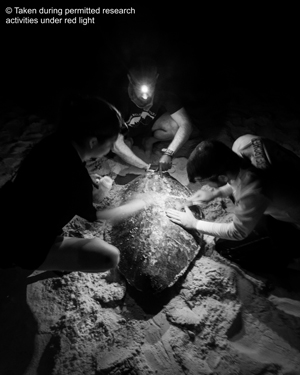Grant: 18-021R
Project Title: Life on Loggerheads: an integrated epibiosis study to assess foraging behavior, reproductive success and habitats of Northern Gulf of Mexico loggerheads nesting at St. George Island
Project Manager: Dr. Mariana Fuentes, Dr. Jeroen Ingels, & Ian Silver-Gorges
Organization: Florida State University (Research and Educational Institute)
Grant Amount: $10,571.40
Completion Date: 2019-06-24
Summary: Knowledge of sea turtle migratory corridors, foraging grounds, and inter-nesting areas is critical to sea turtle management and conservation. Satellite telemetry and stable isotope analysis (SIA) are commonly used techniques for tracking sea turtle movements and identifying foraging areas. Epibionts, animals that colonize the surface of living organisms, colonize sea turtles at their foraging grounds and may thus be used to determine broad areas where nesting sea turtles forage. Here we aim to collect baseline information on the epibiont assemblage of turtles nesting at St. George Island, part of the Northern Gulf of Mexico Recovery Unit. We will integrate our data on epibiosis with SIA to identify and assess the broad foraging areas, and further compare our data to nest inventory data to determine the effects of foraging area on measures of reproductive success. To reach our goals we will conduct fieldwork at St. George Island during the peak of the loggerhead nesting season, approximately two weeks in June, 2018. We will collect morphometric and population data, as well as epibionts and tissue samples for SIA from encountered turtles. Epibionts and SIA will be identified and analyzed, respectively, in the second half of 2018. Various linear models and post-hoc tests will be used to determine significant relationships between epibiont data, SIA, and nest inventory data. Results: We collected tissue samples and the entire carapace epibiont community from 23 nesting loggerhead turtles at St. George Island. Analysis of stable isotope results from tissue samples is ongoing. Macrofauna (organisms >1mm) identification is also ongoing, but meiofauna (organisms >38um and <1mm) identification is complete.
More than 20 higher taxa were recovered from the carapaces, with nematodes, amphipods and copepod nauplius stages dominating the assemblages. Abundance of epifauna was high beyond expectations. Preliminary meiofaunal analysis indicates that the turtles we sampled hosted >32,000 individuals on average. Average meiofauna abundance for separate carapace sections (anterior, medial, and posterior) was >10,000individuals. Preliminary meiofauna community analysis indicates that the loggerheads could be separated in different groups according to their epi-meiofaunal communities.
Nest inventories were conducted for nests lain by 19 out of 23 sampled turtles. Preliminary analyses suggest that emergence success (number of emerged hatchlings/clutch size) may be weakly related to meiofaunal communities (RELATE Analysis, p-level=0.11 & 0.16), but additional samples are necessary to fully investigate relationships between epibiota and reproductive parameters. We will return to St. George Island in 2019 to collect more tissue samples and epibiont samples from nesting loggerheads to improve our sample size.
Results: We collected tissue samples and the entire carapace epibiont community from 23 nesting loggerhead turtles at St. George Island. Analysis of stable isotope results from tissue samples is ongoing. Macrofauna (organisms >1mm) identification is also ongoing, but meiofauna (organisms >38um and <1mm) identification is complete.
More than 20 higher taxa were recovered from the carapaces, with nematodes, amphipods and copepod nauplius stages dominating the assemblages. Abundance of epifauna was high beyond expectations. Preliminary meiofaunal analysis indicates that the turtles we sampled hosted >32,000 individuals on average. Average meiofauna abundance for separate carapace sections (anterior, medial, and posterior) was >10,000individuals. Preliminary meiofauna community analysis indicates that the loggerheads could be separated in different groups according to their epi-meiofaunal communities.
Nest inventories were conducted for nests lain by 19 out of 23 sampled turtles. Preliminary analyses suggest that emergence success (number of emerged hatchlings/clutch size) may be weakly related to meiofaunal communities (RELATE Analysis, p-level=0.11 & 0.16), but additional samples are necessary to fully investigate relationships between epibiota and reproductive parameters. We will return to St. George Island in 2019 to collect more tissue samples and epibiont samples from nesting loggerheads to improve our sample size.